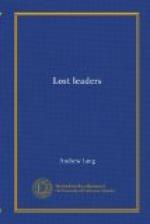Skating has been, within the last few years, a very progressive art. There was a time when mere speed, and the grace of speed, satisfied most amateurs. The ideal spot for skating in those days must have been the lakes where Wordsworth used to listen to the echoes replying from the cold and moonlit hills, or such a frozen river as that on which the American skater was pursued by wolves. No doubt such scenes have still their rare charm, and few expeditions are more attractive than a moonlight exploration of a winding river. But it is seldom that our frosts make such tours practicable, whereas almost every winter it is possible to skate with safety, at least on shallow ponds, or on places like the ice-bound floods at Oxford. Thus figure-skating, which needs but a surface of a few yards to each performer, has come into fashion, and it is hard to imagine any exercise more elegant, or one that requires more nerve. The novice is theoretically aware that if he throws his body into certain unfamiliar postures, which are explained to him, the laws of gravitation and of the higher curves will cause him to complete a certain figure. But how much courage and faith it requires to yield to these laws and let the frame swing round subject to the immutable rules of matter! The temptation to stop half-way is almost irresistible, and then there occurs a complicated fall, which makes the petrified spectator ask where may be the skater’s body—“which are legs, and which are arms?” Of all sports, skating has the best claim to adopt Danton’s motto, Toujours de l’audace—the audacity meant being that of giving one’s self




